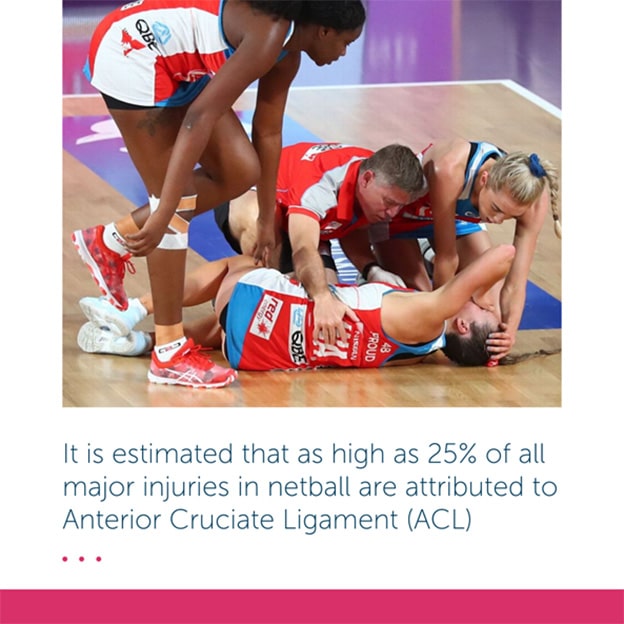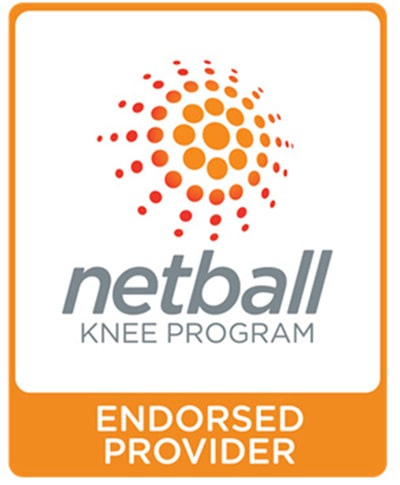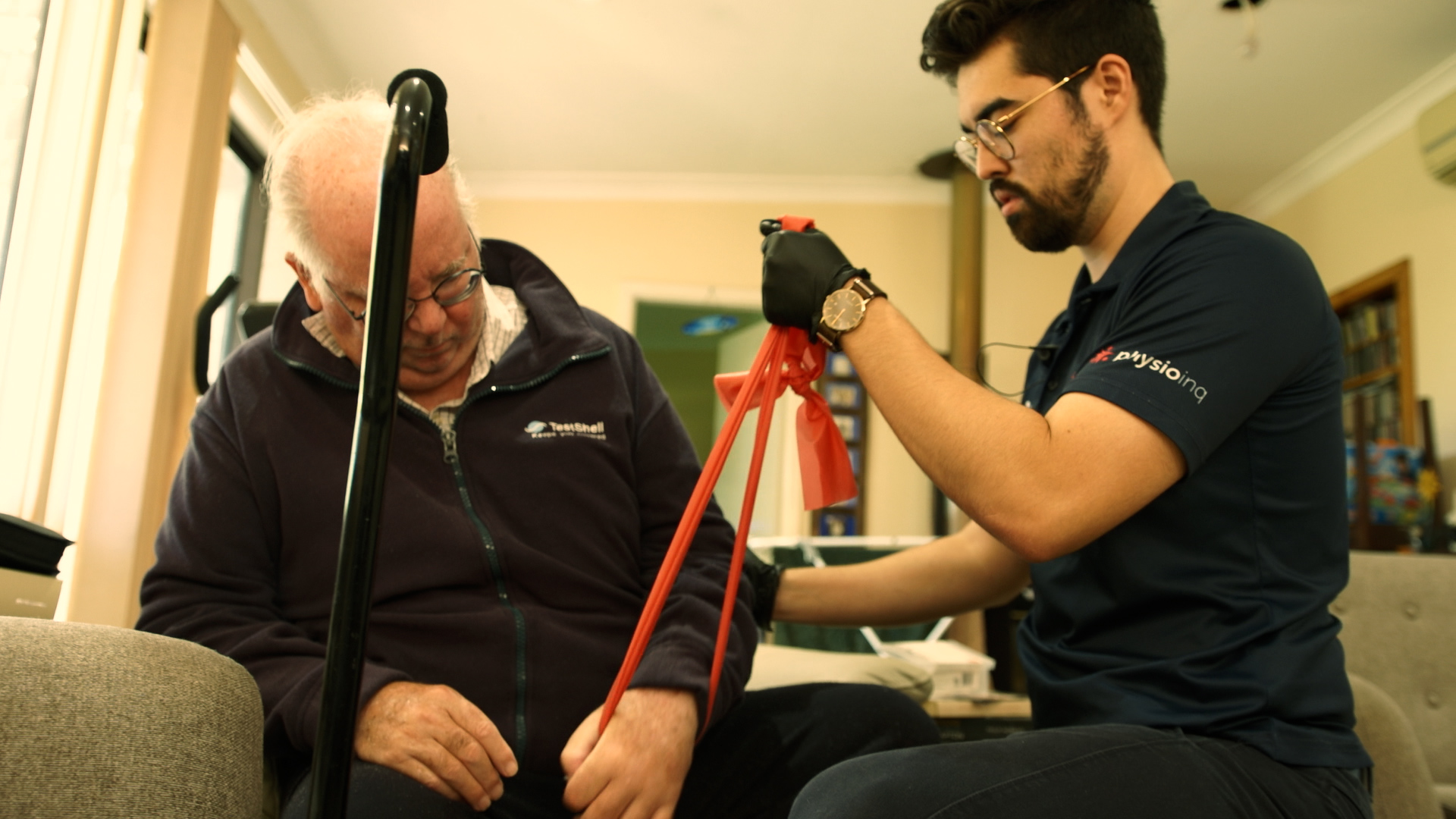Make an Appointment
Netball is ranked as the leading women’s participation team sport and the top team-based sport in Australia for 15- to 24-year-olds.
Netball engages players of all ages from the entry-level juniors, competitive and social recreational players and the elite level, with underage state and national programs through to the National Super Netball and Australian Netball Diamonds. As with any sport, at any level, there is an inherent injury risk to netball players.
Netball Injuries
Knees are one of the most common joints injured in netball. It is estimated that as high as 25% of all major injuries in netball are attributed to Anterior Cruciate Ligament (ACL) injury alone. Not only is the ACL frequently injured, it is also arguably the most costly injury to netballers, resulting in prolonged rehabilitation periods and time away from the sport.

Injury Prevention
The Knee injury prevention for Netballers to Enhance performance and Extend play (KNEE) program has been developed by Netball Australia with the support of the Australian Institute of Sport to provide this education for coaches, players and parents.
Using the principles of existing Injury Prevention Programs, Netball Australia’s KNEE Program has been designed and tailored specifically for netball by the Australian Netball Diamonds Head Physiotherapist.
What are the benefits of the KNEE program?
The benefits of Netball Australia’s KNEE Program are that when it is implemented effectively it has the potential to reduce not only ACL incidence by up to 70% but reduce the incidence of lower limb injuries generally. Not only does the program aim to create a reduction in ACL and lower limb injury risk but also enhances strength, speed and power. It targets landing, deceleration and change of direction technique including attention to arm position to ensure preparedness for the multi-directional demands of netball.
Who is the KNEE program for?
The program has drills aimed at the junior, recreational and elite level player, and can be easily incorporated into any training session or game-day warm up. Any team or player wanting to improve their performance and reduce time off the court due to injury can benefit from this program!
FAQs About Netball and Your Knees
Is netball bad for your knees?
Yes. In short, netball is bad for your knees. However, there are ways to prevent knee injuries in netball that makes the sport less of a risk to your knees and other joints. So, it shouldn’t necessarily be stated that netball is “bad” in any way.
ACL injuries make up 25% of all netball injuries and the other most common netball injuries occur in the knees or lower leg. With all the running, jumping and quick changes in direction and speed during netball play, it makes sense that the sport would wreak havoc on your knees, shins and ankles.
With the right support and cross-training, however, netball can also help to strengthen your knees and is still a wonderful way to stay healthy and fit while having fun. As long as you do your best to prevent injury, you should be able to play any sport safely and for many years.
How to strap a knee for netball?
Knee straps and braces can be helpful for preventing knee injuries, especially if you’re prone to injury or have recently recovered from a knee injury.
You can ask your physiotherapist about the knee straps they recommend and how to wear them safely. Knee straps and braces keep your knee joint stabilised to prevent knee injuries that occur when the ligaments in your knee are overextended or destabilised.
Still, it’s important to always warm-up, cool down and work to increase your joint mobility, in addition to wearing a knee strap during netball play.
How do you prevent knee injuries in netball?
The benefits of Netball Australia’s KNEE Program is that it can truly prevent knee injuries in netball. By educating coaches, players and their parents, the KNEE Program is effective at supporting the prevention of knee injuries through its free resources.
With step-by-step guides and instructional videos on knee injury prevention exercises, more players are able to have access to this quality program and protect their knees for more longevity and enjoyment in the sport.
Overall, proper warm-ups and cool-downs, equipment, knee strapping, nutrition, hydration, cross-training and working with a physio are all keys to preventing knee injuries in netball as well.
How do you tape a knee for stability?
Taping a knee for stability using specialised techniques and physio tape helps to protect your knee ligaments from moving out of their proper place. Whether due to overuse or a past injury, taping or strapping your knee gives your joint the extra support it needs.
Knee taping requires a specific kind of tape to help with this stabilisation. There are places to anchor your tape and certain tautness and give that’s required for a safe end result.
Taping a knee for netball is more complicated than you might think. In most cases, you’ll want to learn how to strap your knee from your physiotherapist to ensure you’re not doing any unnecessary damage.
What are the most common injuries in netball?
The most common netball injuries include:
- Ankle sprains
- Patellofemoral syndrome (PFP)
- Patellar tendinitis or jumper’s knee
- ACL injuries
- Shin splints
As you can see, these injuries are mostly knee injuries which is why the Netball Australia KNEE Program supports players, coaches and parents through these intense injuries.
Implementing the Program
At Physio Inq, most of our clinics throughout Australia have completed the training to be recognized as a KNEE Program Provider Endorsed by Netball Australia.
We look forward to working with local netball clubs to enhance their performance and reduce their injury risk throughout the season.
Manage your body and get the most out of Netball season at a Physio Inq clinic near you or with our mobile physio services!

The program manual, videos and tips for implementing can be found at https://knee.netball.com.au/
Additional Resources
The 5 most common netball injuries and how to prevent them
Date Published: Monday, May 10, 2021
Locate a Mobile Physiotherapy
Service Near me
Get the experience & convinence you deserve to support your or a loved one's allied health needs.
Our Mobile Physiotherapy team are currently serving & taking appointments in the following states and regions in Australia:
Need to get into direct contact with ur Client Services team? We're all ears. Call our team directly on 1300 731 733








